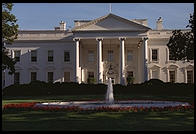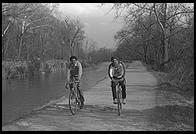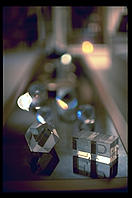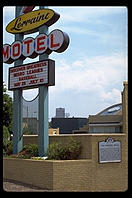
Big Government
by Philip Greenspun; created 1993-1996
Home : Travel : Great Trips : Big Government
 Stroll down the Mall in Washington, D.C. and feel your spirit crushed by the vast
distances separating vast buildings staffed by vast bureaucracies. Drag your puny
self up and down the 8-lane wide avenues until you come within a few blocks of
1600 Pennsylvania Avenue. The intention of James Hoban, the architect, and George
Washington, was that the president live in an ordinary house on the street. There
would be no palace set in a garden fit for a European king. Bill Clinton changed
all of that in 1995. He closed off three blocks of Pennsylvania Avenue, linking
the White House with the gardens of Lafayette Park and snarling traffic for tens
of thousands of commuters. "I didn't do it for myself, but for the safety of the
White House staff."
Stroll down the Mall in Washington, D.C. and feel your spirit crushed by the vast
distances separating vast buildings staffed by vast bureaucracies. Drag your puny
self up and down the 8-lane wide avenues until you come within a few blocks of
1600 Pennsylvania Avenue. The intention of James Hoban, the architect, and George
Washington, was that the president live in an ordinary house on the street. There
would be no palace set in a garden fit for a European king. Bill Clinton changed
all of that in 1995. He closed off three blocks of Pennsylvania Avenue, linking
the White House with the gardens of Lafayette Park and snarling traffic for tens
of thousands of commuters. "I didn't do it for myself, but for the safety of the
White House staff."
Talk to Tom and Bruce, the protesters who've maintained "Peace Park" across from the White House for 20 years. They stubbornly cling to their nuclear disarmament agenda and their spots despite frequent arrests. Connie, an older woman who speaks with what sounds like a heavy Russian accent though she says she is from New York, maintains her own adjacent booth. She'll tell you it is all the fault of the Zionists.
 Once you feel that you have appropriate respect for bureaucracy, allow yourself
to drift into Georgetown where the townhouses and two-lane streets will make you
feel comfortable again. Rent a bike and head west along the Chesapeake & Ohio
canal towpath for about 60 miles to Harper's Ferry. The C&O canal goes
through the gorgeous Potomac River Valley. It was once used by mules to pull
barges up and down the canal, but now is a dirt road maintained by the National
Park Service for about 184 miles of car-free biking. When you get to Harper's
Ferry, you'll have your awe for Big Government restored. John Brown, the Yankee
abolitionist, took over the U.S. arsenal here on October 16, 1859. He was hanged
for his trouble on December 2nd of the same year.
Once you feel that you have appropriate respect for bureaucracy, allow yourself
to drift into Georgetown where the townhouses and two-lane streets will make you
feel comfortable again. Rent a bike and head west along the Chesapeake & Ohio
canal towpath for about 60 miles to Harper's Ferry. The C&O canal goes
through the gorgeous Potomac River Valley. It was once used by mules to pull
barges up and down the canal, but now is a dirt road maintained by the National
Park Service for about 184 miles of car-free biking. When you get to Harper's
Ferry, you'll have your awe for Big Government restored. John Brown, the Yankee
abolitionist, took over the U.S. arsenal here on October 16, 1859. He was hanged
for his trouble on December 2nd of the same year.
Head southwest down the Blue Ridge Parkway to Asheville, North Carolina ("where old Republicans go to die"). Visit the 8000-acre Biltmore Estate, built by a grandson of railroad magnate Cornelius Vanderbilt. If Vanderbilt's Renoirs don't impress you, try 400-foot-high Hickory Nut Falls in Chimney Rock Park. Don't linger, though, because though Asheville may teach you something about the value of owning a Congressman, there is a lot more to this trip.
Drive through Great Smoky Mountains National Park and stop in Gatlinburg's Carbo Police Museum to see the death car of Walking Tall sheriff Buford Pusser. When you're tired of saying "Buford Pusser," then circle around to the southwest to Vonore, Tennessee. The 16,500-acre reservoir before you finishes a job started in the 1830s when the Cherokee Indians were forced into Oklahoma along the Trail of Tears. A few of them hid out in the Great Smokies and continued to visit their ancestral homeland here in what was the Cherokee River Valley. In addition to sacred religious sites, the valley contained Moundbuilder (see "Ancient Ohio") and other archaeological sites going back as far as 6000 B.C.
Pitted against these remnant Cherokees were Tennessee Senator Howard Baker and others who stood to gain from the buying up of 22,000 acres of land adjacent to the reservoir. The Tennessee Valley Authority found it hard to argue for the project, which would generate less than 1/1000th of the TVA's power. They estimated that maintenance alone for the dam would cost more than the taxes being collected from the farmland that would be lost. None of the economic or Indian rights arguments stalled the dam, though. The only effective opposition to the dam came from the snail darter, a minnow that quickly became a media darling. Senator Baker, however, managed to slip an amendment into an energy bill in 1979 to complete the Tellico Dam "notwithstanding the Endangered Species Act or any other law."
Jimmy Carter signed the bill into law, federal marshals evicted the hold-out farmers and burned their houses, the remains of white people that would fall under the impoundment were disinterred and reburied, the remains of Indians were disinterred and distributed to museums, and the Cherokee River is now known as the Little Tennessee. The dam, though, keeps its Indian name of "Tellico." It comes from a Cherokee word meaning "big money."
Before leaving the area, make sure to visit Oak Ridge National Laboratory (see "Learning to Love the Bomb"). Then head west on I-40 to Nashville. Do not leave town without visiting the full-scale replica Parthenon, complete with statue of Athena (protested by Fundamentalist Christians as an article of Paganism). Head southwest on the Natchez Trace Parkway into Alabama. Take a detour into Florence to see an important Mound Builder site, the birthplace of blues legend W.C. Handy, and a few big T.V.A. dams.
Back on the Natchez Trace, shortly after you enter Mississippi, you'll arrived at the Bay Springs visitor center for the Tennessee-Tombigbee Waterway, five times longer than the Panama Canal and requiring one-third more earthmoving. The most amazing thing about the Tenn-Tom is that it survived so many presidential attempts to kill it during the years of its construction, 1972 to 1984. Even after $2 billion had been spent, the cost of completing the project exceeded its economic benefits. If you actually see a barge in the waterway, send me email.
Get off the Natchez Trace at Tupelo and go directly to the two-room house where Elvis Presley spent his first 13 years. Then drive west on SR 6 to Oxford, the university town where William Faulkner lived and wrote. Drive north on SR 7 to Grand Junction, Tennessee, taking care to arrive before 2pm when the National Bird Dog Museum closes. Then head west to Memphis.
 Elvis bought an old brick
house when he was 22, retained its original name of
Graceland, and lived there until he died. He regularly
gave $50,000 to various organizations in town and didn't deduct it from his taxes
because that would "take away from the spirit of the gift." If he really liked
his barber or whomever, he would give him a Cadillac. Elvis is remembered for his
excess but compared to any rich person today, he was really a model of restraint
and generosity. Did you ever hear of
Bill Gates leaving his $40 million
mega-mansion to give a gift to another human being?
Elvis bought an old brick
house when he was 22, retained its original name of
Graceland, and lived there until he died. He regularly
gave $50,000 to various organizations in town and didn't deduct it from his taxes
because that would "take away from the spirit of the gift." If he really liked
his barber or whomever, he would give him a Cadillac. Elvis is remembered for his
excess but compared to any rich person today, he was really a model of restraint
and generosity. Did you ever hear of
Bill Gates leaving his $40 million
mega-mansion to give a gift to another human being?
Stop downtown in Overton Park at the bandshell where Elvis first shook his pelvis on July 30, 1954. Then go to Dr. George Nichopoulos's office at 6027 Walnut Grove. Dr. Nick prescribed 5,300 pills for Elvis shortly before he died. The prescriptions were filled at Prescription House, 1800 Union Avenue.
 Don't leave
Memphis without seeing the 5 pm Duck Walk at the Peabody
Hotel, the blues clubs of Beale Street, and the Lorraine Motel where Martin
Luther King was shot by James Earl Ray. Despite the fact that both were
out-of-towners, the locals have built an interesting National Civil Rights Museum
on the site of the motel.
Don't leave
Memphis without seeing the 5 pm Duck Walk at the Peabody
Hotel, the blues clubs of Beale Street, and the Lorraine Motel where Martin
Luther King was shot by James Earl Ray. Despite the fact that both were
out-of-towners, the locals have built an interesting National Civil Rights Museum
on the site of the motel.
Memphis is the end of the line for you as it was for Elvis and King. To finish up your big government tour, think about the impressive modern buildings you saw in the small towns and cities you passed through. What percentage were casinos, courthouses, or prisons?
If you are actually planning to take this trip, you may wish to look at the user-contributed Related Links page.
Return
to the Great Trips index page
Text and pictures copyright 1993-1996 Philip Greenspun